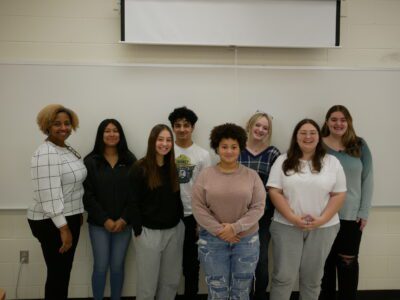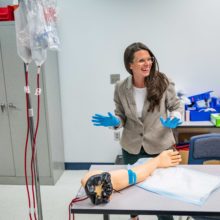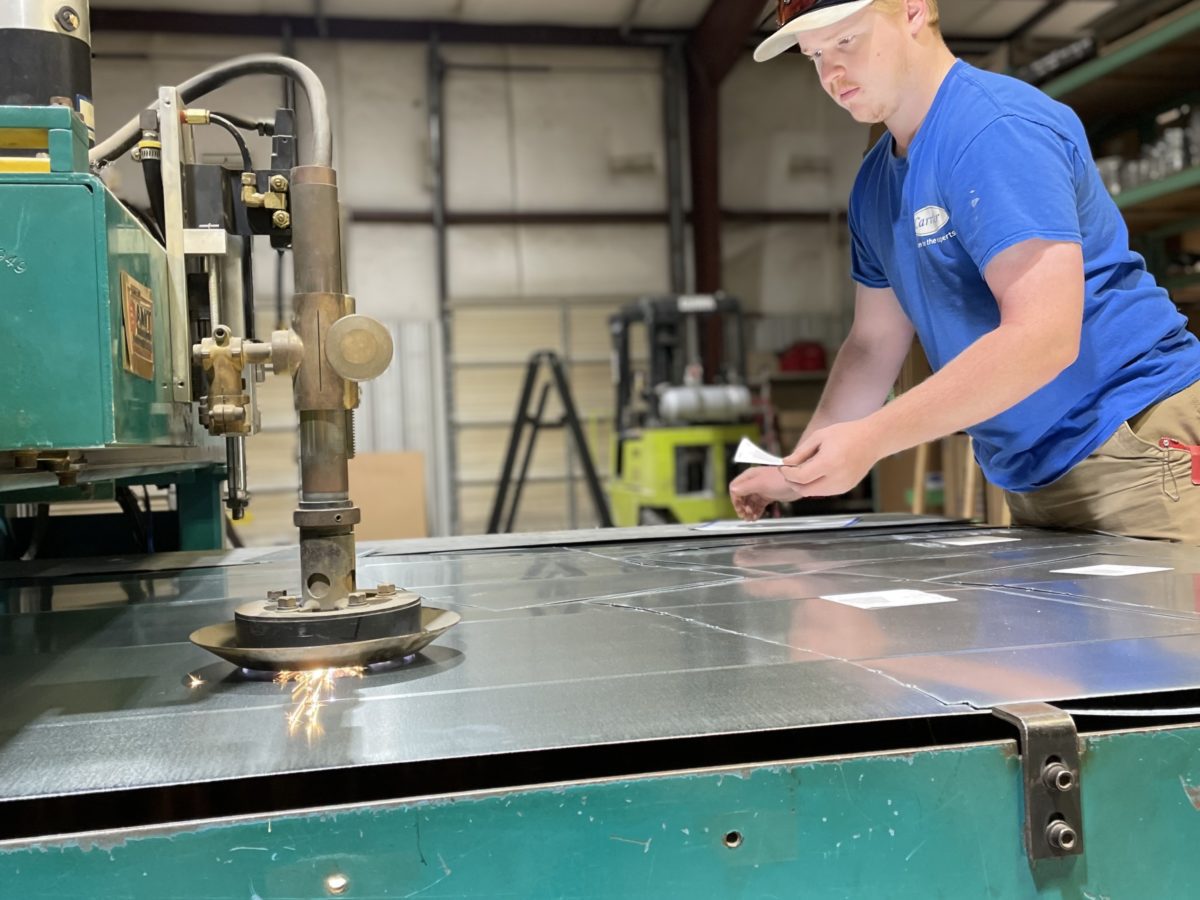
|
|
Highlights
- Career and College Promise is designed to connect students to college and career goals, whether they intend to transfer or go directly into the workforce after high school graduation.
- North Carolina’s CCP students outperform the general student population at community colleges.
- Economically disadvantaged and underrepresented students benefit most from CCP participation, though challenges remain in program accessibility.
Maddox Brown’s passion for HVAC grew from taking classes through Career and College Promise (CCP), a North Carolina dual enrollment program that allows students to take college courses tuition-free while enrolled in high school.
Those classes helped Brown turn his passion into a career. He graduated high school with a certificate in Air Conditioning, Heating & Refrigeration Technology, made possible by the Career and College Promise program.
Now, Brown is a first-year apprentice with a local heating and air company in Shelby, where he is gaining hands-on experience and earning additional credentials through the North Carolina Community College System (NCCCS). Brown’s employer said if he hits all his goals, Brown could have an annual salary between $60,000 to $80,000 by the age of 21.
Last fall, EdNC visited all 58 community colleges over the span of four months to learn more about their impact.
During these visits, we spoke to faculty, staff, and students about the impact Career and College Promise has had on their lives and communities. Here’s what we learned.
Sign up for Awake58, our newsletter on all things community college.
What is Career and College Promise?
In 2011, North Carolina’s State Board of Education and State Board of Community Colleges established the Career and College Promise (CCP) program. The program’s design provides structured opportunities for high school students to earn college credits tuition-free that “lead to a certificate, diploma, or degree as well as provide entry-level jobs skills.”
Although CCP is relatively new, dual enrollment programs have a long history in the state. For more than 30 years, North Carolina students have been able to enroll in college courses while attending high school. The authorization of CCP consolidated and replaced all other dual enrollment programs in the state to increase the effectiveness of concurrent enrollment.
Eligible students can choose between three different pathways under CCP:
- College Transfer Pathways (CTP): tuition-free courses toward a number of transfer degrees, including the Associate in Arts and Associate in Science.
- Career and Technical Education (CTE) Pathways: tuition-free courses toward a certificate or diploma. These include Workforce Continuing Education (WCE) courses that can lead to a state or industry-recognized credential.
- Cooperative Innovative High Schools (CIHS): high schools typically located on college campuses that provide opportunities for students to complete an associate degree or earn up to two years of college credit within five years.
Eligibility requirements vary between pathways but typically consider a student’s grade level, unweighted GPA, or college readiness through an assessment. CIHS program eligibility is established jointly by local boards of trustees with special emphasis placed on first-generation college students. A full list of eligibility requirements can be found here.
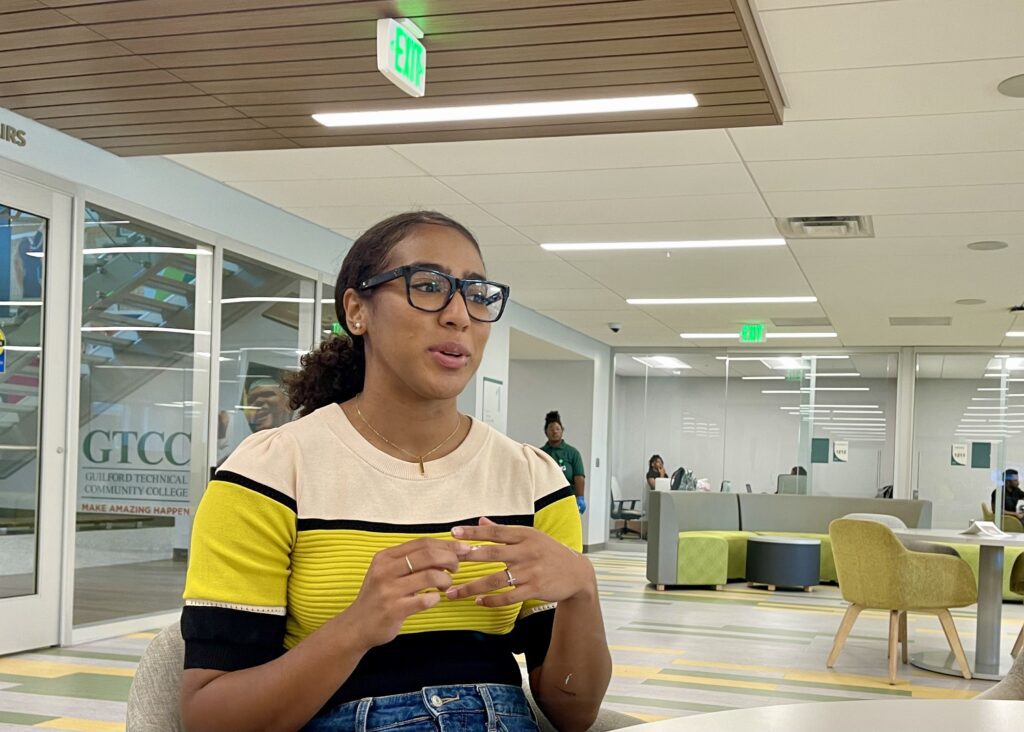
What does Career and College Promise do for students, families, and the state?
Throughout the years, CCP has been recognized by the Education Commission of the States as a model for dual enrollment programming and policy. That distinction is attributed to CCP’s pathways design, statewide policy, funding, and collaboration across education systems.
But CCP is more than just a model program for others. CCP creates real impact – and the benefits extend to students, families, and the state.
Who participates in CCP?
A 2023 draft report to the General Assembly presented during the State Board of Education’s February meeting showed almost 70,000 high school students participated in Career and College Promise during the 2021-22 academic year. That number represents public, charter, private, and home school students across North Carolina.
Cooperative Innovative High Schools accounted for 31% of CCP’s total population. The remainder, 69%, were enrolled in College Transfer Pathways (CTP) or Career and Technical Education Pathways (CTE).
Looking at CTE and CTP data from the 2021-22 academic year, students enrolled in 161,299 credit-level college courses. Those same students completed 84% of their credit-level courses, compared to 71% of the general student population.
The average GPA was 3.19 for students enrolled in either CTP or CTE during Fall 2021. At the end of the 2021-22 academic year, students in CTP and CTE pathways earned 2,861 credentials across the North Carolina Community College System.
Data from NCCCS shows CCP students are primarily female (61%) and white (59%). CTE pathways accounted for the highest male population (54%), and CIHS had the highest percentage of non-white students (52%).
You can find more data and information about Cooperative Innovative High Schools here.
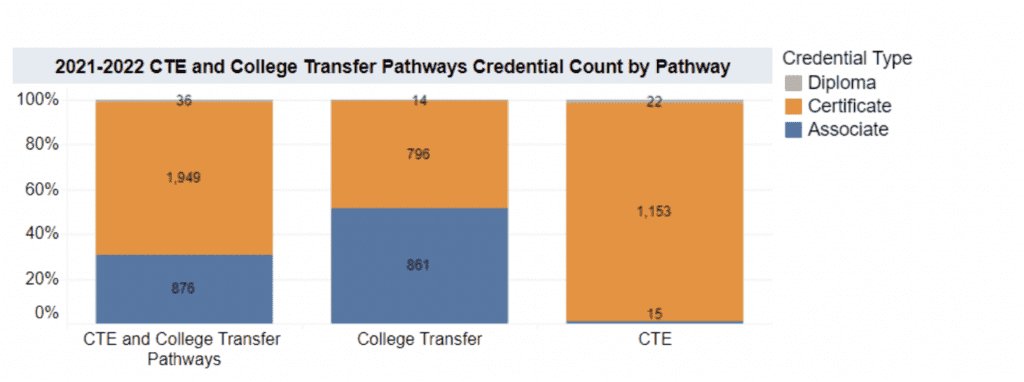
Student outcomes
A five-year grant study that started in 2019 showed students who participated in CCP had higher high school graduation rates and higher postsecondary enrollment rates than those who did not. The study compared CCP students to a similar group of students who did not participate in CCP over seven years.
Students in CTP or CTE Pathways were 9% more likely to enroll in a North Carolina public college after high school. CIHS students were 27% more likely to enroll in a North Carolina public college after graduating.
The study also found that economically disadvantaged students and those from underrepresented racial and ethnic groups benefited most from CCP.
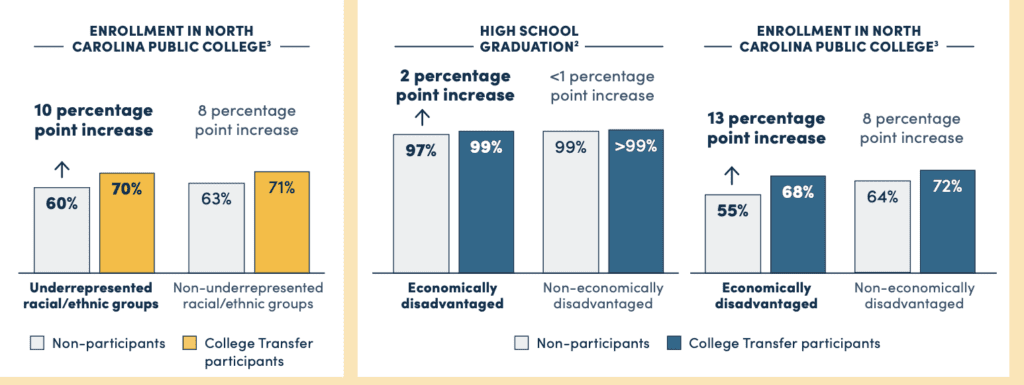
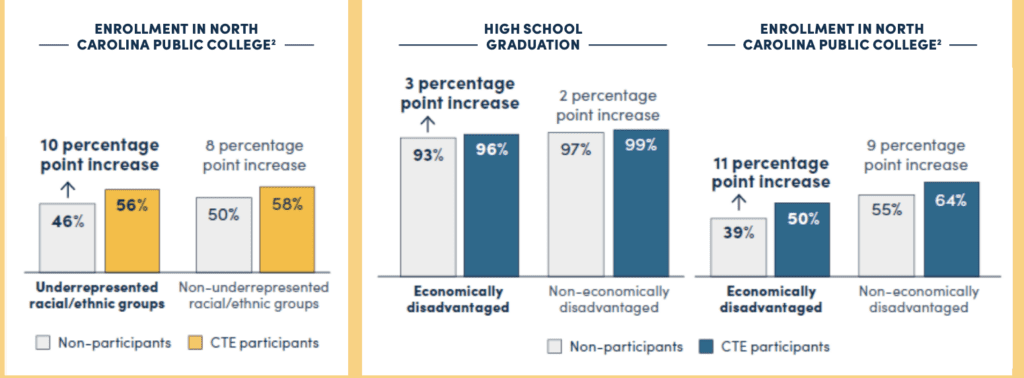
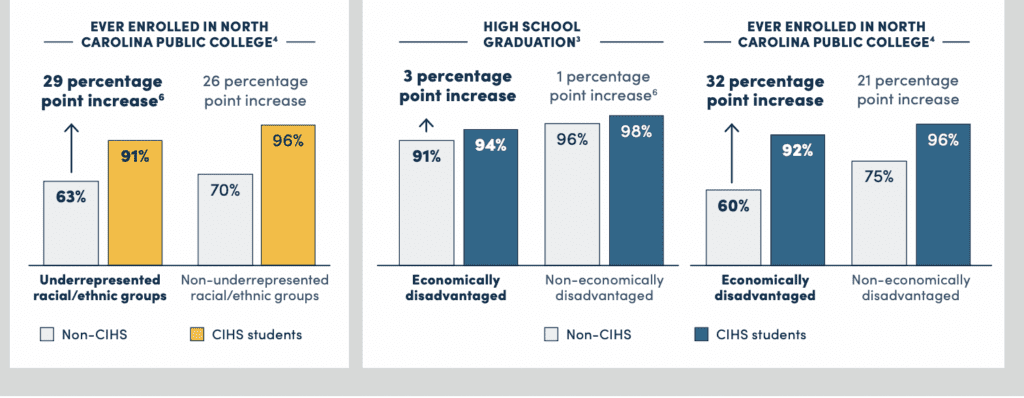
Mark Ellison, dean of students at Southwestern Community College, said students who have not been exposed to college growing up may feel at a disadvantage, and this lack of experience can often be a deterrent when it comes to making decisions about postsecondary enrollment.
Participation in CCP exposes students to college and is a tremendous confidence booster, particularly for first-generation college students, Ellison said.
“Students become familiar with college in a way they may not have otherwise been, and it can change their post-grad career paths and influence them to go to college when they otherwise would not have,” he said.
When community colleges started asking adults why they weren’t in college, a common answer was fear — both fear of failure and fear of the unknown. Earning college credit in high school is one way to help students overcome that fear and bridge the gap in postsecondary attainment.
A 2021 study also found that CCP participation among public high school and charter school students in 2019-20 was higher in Tier 1 counties, which are the state’s most economically distressed counties.
“So many students who come to do this (CCP) would not have explored college otherwise,” said Dr. Chad Bledsoe, president of Montgomery Community College.
For a lot of students, participating in CCP is a direct path to their career right after high school graduation. Like Brown, students all across the state are earning industry standard credentials that position them to join the workforce immediately. And many are earning family-sustaining wages.
Leaders from Stanly Community College shared that a recent CCP participant who earned a welding certificate landed a job after graduation as a welder making $30 an hour. CCP success stories like this are common.
When CCP was designed, it was done in such a way that students could earn a credential in less time than would normally be required. And regardless of their path – obtaining a degree, earning college transfer credits, or pursuing a credential to transition to the workforce – students would save time and money, both of which are linked to increased likelihood of postsecondary attainment.
Leia Rollins, coordinator for college high school programs for Piedmont Community College and the career coach in Caswell County, said the impact CCP makes on students prepares them to go on and change other people’s lives. These students graduate, she said, and they go into the real world and play important roles on the small scale and the larger scale in their communities.
“I want policymakers to see what CCP has done for all of my students,” Rollins said, “from a student taking one class to a student who got their degree. I have a student who is working with minority females about breastfeeding awareness and going on to get her doctorate.”
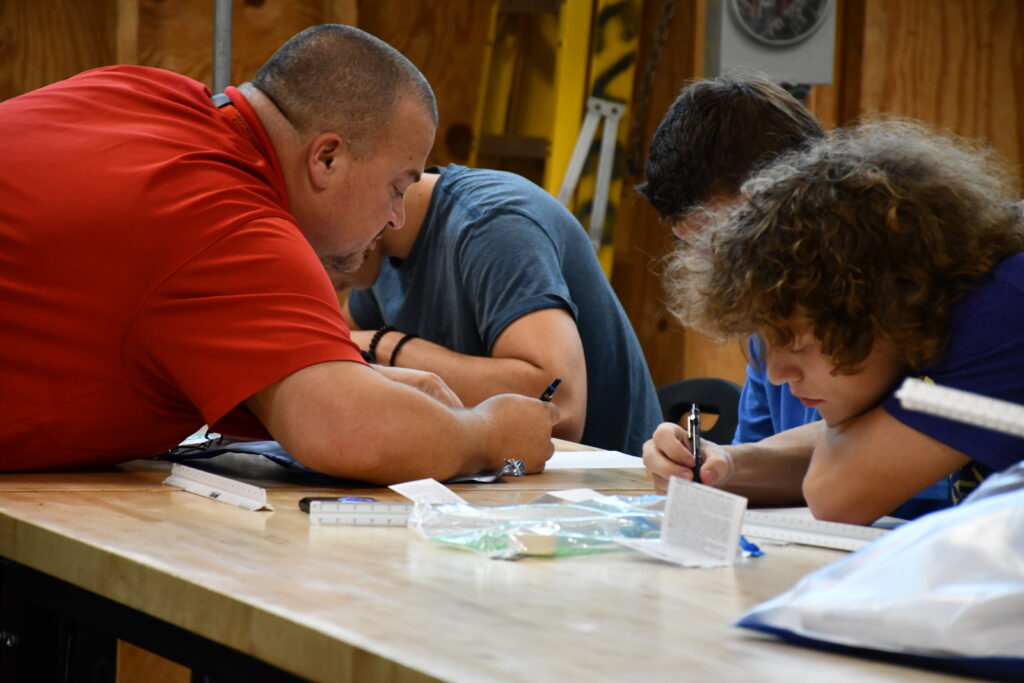
Funding model as a key to success
Cost remains one of the top barriers for students considering whether to pursue postsecondary education after high school.
In November 2022, Education Commission of the States released a special report indicating that “funding models are one of the key determinants of equitable student access to dual enrollment programs,” highlighting North Carolina as a case study.
North Carolina waives tuition costs for CCP students and provides funding to postsecondary institutions who deliver CCP courses. Students are responsible for additional costs, like books, supplies, fees, and transportation, though some school districts and/or colleges may cover these costs.
Bryan Miller, the county manager in Caswell County, said Piedmont Community College’s CCP offerings save students and parents thousands in tuition, room and board, meals, and travel costs. Piedmont Community College also works with the school districts to provide hot spots, supplies for classes, and transportation to students.
On top of all these savings, he said, CCP “puts students in the workforce earlier.”
Miller said when a student is able to start their career two years early, the increases in salary and promotions gained over time have an exponential impact, like compounded interest, on their life.
The draft report to the General Assembly shows an estimated cost analysis for CCP. The report responds to legislative requirements to evaluate the success of students participating in CCP as well as analyze the cost of students participating in the program. The State Board of Education will vote on the final report in March, and EdNC will report on it then.
Partnership and proximity
CCP’s success and recognition as a model for dual enrollment are due, in part, to strong partnerships between high schools and community colleges.
That partnership often looks like shared space between K-12 schools and colleges, shared faculty, splitting costs, and collaborating to alleviate transportation woes. It requires K-12 and college leaders to work together to figure out how to best serve the students in their communities.
In October 2022, the State Board of Education adopted a policy that requires each local education agency (LEA) to develop a partnership agreement with their CCP college partner. This is to ensure quality programming for students.
“The agreement will include a description of how the LEA will integrate CCP program offerings aligned to regional economic and community needs.
The CCP Partnership Agreement will include a description of how the LEA will integrate CCP program offerings aligned to regional economic and community needs and address the following topics (at a minimum) in collaboration with their college partner:
– Establishment of partnership protocols, including regular communication.
– Integration of LEA and college program offerings.
– Plan of communication to students/families to broaden access.
– Student academic support systems, including advising and sharing student progress.
– Responsibilities of school/district and college personnel.
– Responsibilities for program expenses.
– Responsibilities of site operations, including use of facilities and transportation.”
Proximity to the community college impacts access
The mission of North Carolina community colleges is to “open the door to high-quality, accessible educational opportunities that minimize barriers to postsecondary education, maximize student success, develop a globally and multi-culturally competent workforce, and improve the lives and well-being of individuals.”
One way community colleges create access is by their proximity to the communities they serve. Some serve just one county, but many serve what is called a service area, which can include as many as seven counties.
In our travels, it was clear that proximity to the community college makes a difference in terms of how robust the CCP opportunity is for students.
In Caswell County, the brand new high school is located within walking distance of the satellite campus of Piedmont Community College (PCC).
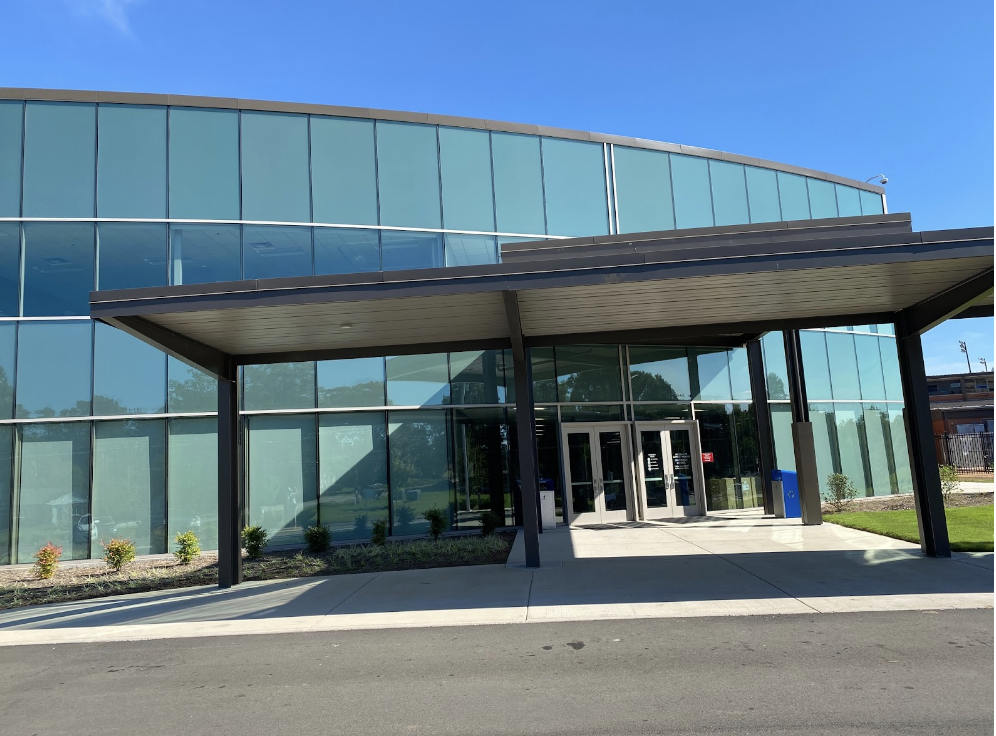
“The access to college that Piedmont Community College started in conjunction with Bartlett Yancey High School is so valuable to this community because it gives those students a head start,” Miller, the county manager in Caswell County, said.
There isn’t an early college in Caswell, but PCC offers an accelerated associate degree that students can earn along with their high school diploma in four years. Last year, 12 students graduated from that program.
In places where in-person access to a community college is challenging because of physical distance, access to online opportunities is critical.
Other challenges and barriers to access
CCP is an incredible opportunity, but as we traveled, we learned more about what challenges colleges, school districts, and students still face when it comes to the program’s accessibility.
Coordinating enrollment
Over and over again in our travels we realized access was sometimes limited depending on the order of how classes for students are scheduled: Are high school classes scheduled first or are CCP classes scheduled first?
Students served by PCC schedule their CCP classes first, and then coaches work with guidance counselors to schedule high school courses. When there are conflicts, PCC will offer the high school classes on campus to make sure students can take what they need to take — or vice versa. For example, welding is offered at the high school in Caswell County.
“We work really closely with the guidance counselors,” said Rollins. “They are on board with CCP. Communication is key.”
They communicate by texting, calling, email, the Remind app, and even tracking people down in person.
“All the things,” Rollins and Kailey Oakley, a career coach in Person County, said together.
Buy in matters
CCP coordinators shared with us just how important buy in from principals and teachers is, especially from those who teach Advanced Placement (AP) courses.
For some students, the need to take the AP test and get a certain score in order to receive college credit makes CCP a better alternative.
“It starts with friendship and trust, seeing and working together every day,” Rollins said.
The need for buy-in extends beyond the walls of the classroom. Rollins and Oakley have regular meetings with local industry and the district’s central office and planning periods with guidance counselors to check in about particular students.
“We are located in the high school,” said Rollins. “We have an office in the counselor/student services suite. We are there for them to see every day.”
They also have an office at PCC near the faculty offices. Proximity matters in both cases.
Rollins said those close relationships help everyone understand “the common goal is to serve the student and help the student.”
Oakley added, “We act as if we are also employees of the school.” She goes to employee appreciation events and sporting events. She attends open houses and department meetings.
“Being there, being present in the schools, just being a part of the faculty even if it doesn’t involve PCC is important,” Oakley said.
“It can be hard at first,” Rollins acknowledged. “It’s just like building any important relationship.”
PCC holds an appreciation breakfast with central office leaders and middle school and high schools counselors in both counties.
“It’s our way to offer kudos for all their hard work and loving our partnership,” said Rollins.
Adequate staffing is also important to success. PCC, for example, has four team members dedicated to supporting CTE and CCP.
‘This isn’t for everyone’
On our travels, we asked CCP coordinators about barriers to performance and completion in the program.
Rollins started by saying, “This isn’t for everyone. It is college.”
But she went on to say it is important to identify the exact challenges to performance and completion and “to get ahead of the problem.”
For example, some of her CCP students were struggling with pre-calculus. They had online math in high school because of COVID-19, and she described their understanding of key concepts as “wavy, understandably.”
To get ahead of that problem, PCC set up a peer tutoring program by CCP students for CCP students. In some cases, they have required tutoring from the beginning, not waiting for there to be a problem.
Rollins said they augmented the peer tutoring program with group tutoring led by an assistant principal in the district who is also a math instructor.
“It’s readying them for real life, for college, for a job,” she said. “This is a great bridge for them to learn with the extra supports in place.”
Modeling equity for the state
Research from the IES grant study indicates certain populations of students are less likely to take advantage of CCP. The CIHS pathway has the most equitable participation by race and ethnicity, followed by the CTE pathway. The CTP pathway has the biggest disparities in participation.
Rollins emphasized that CCP doesn’t just help one kind of student.
“We want to make sure that all students have access,” she said. “I think as a state we started looking at equity, and we have been showing that in our program. We are guiding the way on how our state should look at everything. We are really trying to break down those walls, and we could be an example.”
Enrollment is rising across all of the pathways in both counties, Rollins said and PCC confirmed. That’s in part because of marketing, including videos like this one:
Moving the needle
During our time on college and high school campuses, we heard from a number of students and leaders as we discussed the nuances of CCP, its impacts, funding, and why it matters.
When the EdNC team asked why it matters, voices cracked and some shed tears. Listen to this response from Rollins.
Rollins wants legislators to meet students in different pathways and alumni to hear about their employment experience. She wants them to understand the experience from the very beginning into the real world. She wants them to understand that CCP students are seen as role models by traditional students.
For those that work with CCP students, access to these opportunities is emotional because it matters.
It matters to the student who thought college was out of reach because of finances. It matters to the student who struggled with self-confidence, never imagining that passing a college-level course would be the boost they needed. It matters to the student who found their calling in an HVAC class and now wakes up every morning excited to go to work.
And it matters to the state, as we push toward the postsecondary attainment goal in hopes of building a strong workforce for future generations.
“We are the place that helps transform people’s lives. We are changing the dynamic across generations of families by helping people understand that college can be part of their reality. That’s the power, that’s the magic of what we bring to this community every single day.”
Dr. Pamela Senegal, president of Piedmont Community College
Editor’s Note: Leia Rollins is tweeting about her experience serving CCP students throughout the school year. You can follow her here.
Recommended reading
